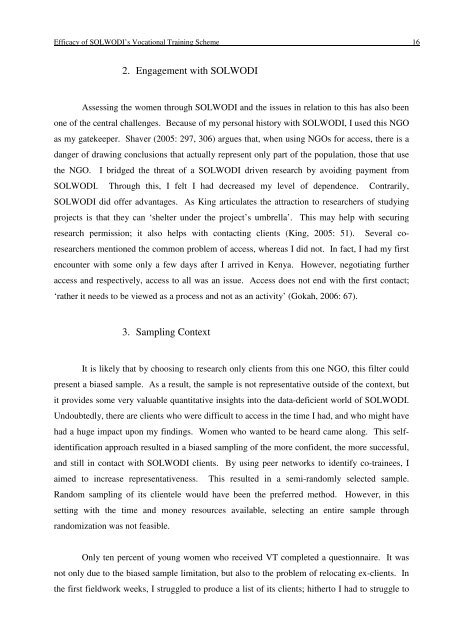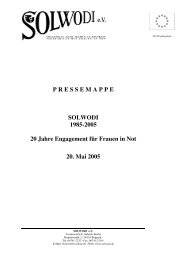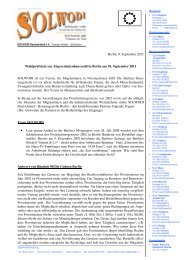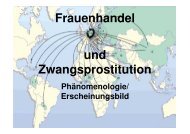Sponsored Vocational Training: Dream of Escape or Reality - Solwodi
Sponsored Vocational Training: Dream of Escape or Reality - Solwodi
Sponsored Vocational Training: Dream of Escape or Reality - Solwodi
You also want an ePaper? Increase the reach of your titles
YUMPU automatically turns print PDFs into web optimized ePapers that Google loves.
Efficacy <strong>of</strong> SOLWODI’s <strong>Vocational</strong> <strong>Training</strong> Scheme 16<br />
2. Engagement with SOLWODI<br />
Assessing the women through SOLWODI and the issues in relation to this has also been<br />
one <strong>of</strong> the central challenges. Because <strong>of</strong> my personal hist<strong>or</strong>y with SOLWODI, I used this NGO<br />
as my gatekeeper. Shaver (2005: 297, 306) argues that, when using NGOs f<strong>or</strong> access, there is a<br />
danger <strong>of</strong> drawing conclusions that actually represent only part <strong>of</strong> the population, those that use<br />
the NGO. I bridged the threat <strong>of</strong> a SOLWODI driven research by avoiding payment from<br />
SOLWODI. Through this, I felt I had decreased my level <strong>of</strong> dependence. Contrarily,<br />
SOLWODI did <strong>of</strong>fer advantages. As King articulates the attraction to researchers <strong>of</strong> studying<br />
projects is that they can ‘shelter under the project’s umbrella’. This may help with securing<br />
research permission; it also helps with contacting clients (King, 2005: 51). Several co-<br />
researchers mentioned the common problem <strong>of</strong> access, whereas I did not. In fact, I had my first<br />
encounter with some only a few days after I arrived in Kenya. However, negotiating further<br />
access and respectively, access to all was an issue. Access does not end with the first contact;<br />
‘rather it needs to be viewed as a process and not as an activity’ (Gokah, 2006: 67).<br />
3. Sampling Context<br />
It is likely that by choosing to research only clients from this one NGO, this filter could<br />
present a biased sample. As a result, the sample is not representative outside <strong>of</strong> the context, but<br />
it provides some very valuable quantitative insights into the data-deficient w<strong>or</strong>ld <strong>of</strong> SOLWODI.<br />
Undoubtedly, there are clients who were difficult to access in the time I had, and who might have<br />
had a huge impact upon my findings. Women who wanted to be heard came along. This self-<br />
identification approach resulted in a biased sampling <strong>of</strong> the m<strong>or</strong>e confident, the m<strong>or</strong>e successful,<br />
and still in contact with SOLWODI clients. By using peer netw<strong>or</strong>ks to identify co-trainees, I<br />
aimed to increase representativeness. This resulted in a semi-randomly selected sample.<br />
Random sampling <strong>of</strong> its clientele would have been the preferred method. However, in this<br />
setting with the time and money resources available, selecting an entire sample through<br />
randomization was not feasible.<br />
Only ten percent <strong>of</strong> young women who received VT completed a questionnaire. It was<br />
not only due to the biased sample limitation, but also to the problem <strong>of</strong> relocating ex-clients. In<br />
the first fieldw<strong>or</strong>k weeks, I struggled to produce a list <strong>of</strong> its clients; hitherto I had to struggle to






